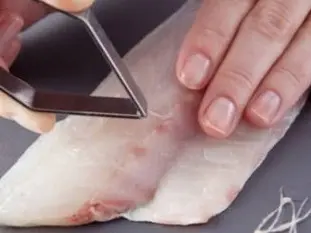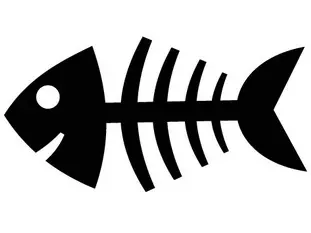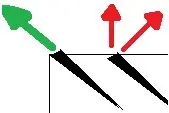Remove bones from fish

Let's talk about fish: It's not a scoop, it's much more pleasant to eat fish from which all the bones have been carefully removed, even if it's a rather painful and time-consuming job, the result is worthy of your efforts.
Here are some important points to keep in mind.
Here are some important points to keep in mind.
14 K 5/5 (14 reviews)
Keywords for this post:FishBonesClawFleshFilletFish steakLast modified on: October 16th 2021
Remove bones from fish
the tool
No secret, you absolutely need a pair of fishbone pliers, it's really the essential tool with enough strength to be able to catch and remove a fishbone, usually very well hung.You can use a pair of universal or fine-nosed tweezers, but it's not very practical (don't even think about recycling an old pair of tweezers, you won't get anywhere).
If you have to buy one, go for a stainless steel one, like the one on the picture above.
Finding the fish bones
This is not so easy, as they are usually almost invisible.The best way is to put the fillet or the fish in front of you (on a plate if possible) and to pass your finger along the flesh, if the bones are not visible, on the other hand they can be felt.
Removing them
That's the trick, it's not obvious but there is a kind of "direction", fish bones are generally oriented from the head to the tail, from the central bone and slightly curved, schematically, like this:
Add to this that there is a tip and a point, the tip being significantly larger than the point.
If you magnify it a lot, a fish bone looks like this:

So they are in the flesh like this:


Well, it wouldn't be dramatic either, but 1) it will be harder and 2) you might tear off some flesh with the edge, which would be a shame.
So you have to do that for all the bones, until you run your finger over them and you don't feel any point, then move on to the next fillet.
Yes, yes, it's long and painful, but what a pleasure afterwards at the table...
To sum up: To remove the bones from a fillet or a fish steak, you need a good pair of bone grippers, and pull them in the opposite direction of their location.
Lasts posts
Butter vs. grease
We often read in a recipe where a pastry is put into a mould that, just before pouring, the mould should be buttered or greased. But what's the difference between these 2 terms?December 1st 20251,1565
Getting out of the fridge early
Very often when you're cooking, you need to take food or preparations out of the fridge, to use them in the recipe in progress. There's nothing tricky about this: you just take them out of the fridge and use them, usually immediately, in the recipe. But is this really a good method?November 24th 20251,1905
Who's making the croissants?
When you look at a bakery from the outside, you naturally think that in the bakery, the bakers make the bread, and in the laboratory, the pastry chefs make the cakes. It's very often like that, with each of these professions having quite different ways of working, but sometimes there's also one...November 23th 20251,088
Oven height
When we put a dish or cake in the oven, we naturally tend to put it on the middle shelf, and that's what we usually do. But in some cases, this position and height can be a little tricky, so let's find out why.October 8th 20252,9505
The importance of sieving
In recipes that use a fine powder (flour, powdered sugar, etc.), you'll often see the advice to sift before using it. To sift is to pass the powder in question through a sieve (a very fine strainer) before incorporating it into your recipe. It's often advice, but is it really useful?September 3rd 20257,6653
Other pages you may also like
The bitterness of endives
As I write these lines, we are entering the endive season, and if you like it, it's time to enjoy it, if possible with your local producers. Endive is good, but the reproach that is often made of it, and children in particular, is: "It's bitter! And it is (somewhat) true of course, endives...February 9th 201914 K4.9
Kitchen ovens
You certainly have one in your kitchen, an oven, the essential tool for all kinds of cooking, whether in the kitchen of course, but also in pastry, bakery, pizza, and many others. Here is some information on its structure and operation.May 16th 202034 K4.4
What is the difference between bakery and patisserie?
This is a question that you may well have asked yourself and which I will attempt to answer. In France the two trades of "boulangerie" (bakery) and "pâtisserie" (patisserie and confectionery) have always been quite distinct, but where exactly do the boundaries lie? .February 7th 2017134 K 14.1
Candied fruits: don't get ripped off
Do you like candied fruit? You might like to nibble a handful or add it to a recipe, like a classic fruit cake or delicious Italian specialities like panettone or sicilian epiphany pie.June 21th 201767 K 24.2
A few tips for effective kneading at home
When you have to knead dough for bread or some other recipe, you may well use a food processor or the type of machine known as a stand mixer. The best-known brands are Kenwood and KitchenAid. They are useful tools, but here are a few tips to help you get the best out of them.June 23th 2021284 K 23.8
Post a comment or question
Follow this page
If you are interested in this page, you can "follow" it, by entering your email address here. You will then receive a notification immediately each time the page is modified or a new comment is added. Please note that you will need to confirm this following.
Note: We'll never share your e-mail address with anyone else.
Alternatively: you can subscribe to the mailing list of cooling-ez.com , you will receive a e-mail for each new recipe published on the site.









